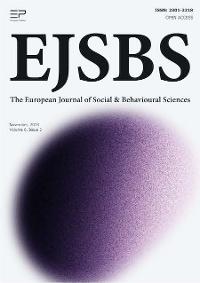Abstract
The focus of this paper is constructed through 1) a child wellbeing study performed in Finland (2010-2012), and 2) music education as a form of creativity. Imagination, creativity, friendliness and the elements of comfort were found to be important for the positive wellbeing of a child. PISA studies reflect the peak of Finnish learning results concerning 15 -year-olds as a proof of the high quality of school education. Maintaining the positive learning results may be based on and supported by music education and creative musical experiences. This leads us to think about holistic music education as a resource.
Keywords: Child-based mehodology, creativity, learning, music education, PISA, triangulation, wellbeing
Introduction
According to an old African story, when a young woman wants to have a baby, she goes far away from the village and finds a place of her own under a big old tree. There she sits and waits, sits – waiting to hear the song of her child. When she hears this song, she learns it to remember it well. Only after this she is ready to get back into the village, to find the man who is to be the farther of the child. The woman teaches the song of their child to this man. While making love to conceive the child, they sing this song together to welcome the child. During the pregnancy, the old women of the village are taught this song so that they will be able to welcome the child into this world with the familiar song. Gradually, all the villagers will learn this song. It will be a part of this person’s life throughout his life, in joy and in sorrow. For the last time, the song will be sung to him at the deathbed (Sobonfu Somé of the Dagara tribe, in www.birthpsychology.com.) This beautiful story leads us smoothly to understand the musical processes as a part of a human’s life, music as an innate capacity, with the connections of wellbeing.
The meaning of arts and culture in our lives are reminded us by Unesco’s ‘Declaration of Children’s Rights’: in article 31 the child’s right to rest and play is emphasized, linked with the idea of leisure time with arts and culture (http://www.cyberschoolbus.un.org/crc/text.html) in connection with socio-emotional and holistic wellbeing.
Musical experiences can also have effects, and therefore used as a tool also for the aims and purposes of positive equilibrium (Marjanen et al., 2012). Music itself, however, is functioning in our consciousness, even unconsciously.
The aim of a study project called Lasten Ikihyvä – The Positive Equilibrium of Children (http:/www.lastenikihyva.fi/p/the-positive-equilibrium-in-english.html) was to clarify the construction of positive wellbeing as experienced by the 8-12 year-old children. The study was performed from 2010-2012 at the area of Päijänne Tavastia (Päijät-Häme) in Southern Finland, with the aims divided into content oriented, methodological and methodological-content-oriented-developmental research aims.
Finnish school has become world famous because of the results of the PISA studies reported. The Finnish comprehensive school has been found to be successful in providing the majority of its students with a solid foundation for further schooling. It also provides the adolescents after school for the transition to working life and for participation in the modern society (Välijärvi et al., 2003), as reported still in the fourth report. In the last report (2012), a clear decrease was found at the area of mathematics, with a declining on reading and science literacy (http://www.minedu.fi/OPM/Tiedotteet/2013/12/pisa.html?lang=en). The results on pupils’ attitudes, motivation and experiences of the school community, were not so encouraging either in the 4th report (Sulkunen et al., 2012).
In this paper, some considerations are made from the settings of the Positive Equilibrium of Children study, and the Pisa studies, concerning interaction with the power of music on us humans, despite the different age groups under focus. This is why musical activities working in our minds, are set as a focus, connected with well-being, creativity and holistic learning processes. In this paper, the present study is only used as a background from the content-based aim point of view; to consider the power of music (education) with its theoretical basis to be mirrored against each other.
The main theories supporting the Positive Equilibrium-study performance were 1) the theory on holistic, deep learning experiences (Hannaford, 2004), 2) The Flow Theory (Csikszentmihalyi, 1990), and 3) The Ecological Systems Theory (Bronfenbrenner, 1979). These theories serve also music education purposes in the current approach. The present background study included qualitative and quantitative data as a part of triangulation. How or what kind of understanding can we learn of the result information reported, to support the well-being within the society?
Theories
The Positive Equilibrium of Children – study
The voice of the child has frequently been the main focus of interest. No matter of the approach to child wellbeing and its scenarios, child-based study methods have often been found as quite a challenge. The chronological and developmental changes concerning the growth and development of the child, and the connections of the target group’s age with the study methods chosen set a variety of challenges for the researcher. The theories on child development are to be understood, and even, in the best situation, supported by practical experience of children: this supports the researcher in creating the contact with the child. In this study, the child’s experiences were set as the focus. It was found important to have the individuals tell things in ways found personally suitable and motivating, and at the same time emphasizing the idea of revealing the construction of positive wellbeing as a whole.
Carla Hannaford (2004) clarifies the deep level, holistic learning experiences, and Mihály Csikszentmihalyi (1990) describes the flow experiences, in the current perspective comprehended as factors to affect the individual experiences of a child living in the micro system level, which is here set as a main focus. It is important to remember, however, that there is interaction going on between the various phases or stages within the community (Bronfenbrenner, 1979; Peirson et al., 2011). The first experiences are formed and submitted through emotions, bodily features, atmospheres and sound worlds, and strongly affected by music, perceived in the form of sounds.
The learning processes to gain the ability to communicate, start prenatally, affected by musical experiences shared with the fetus and the mother (Chamberlain, 1996; Marjanen, 2009a).
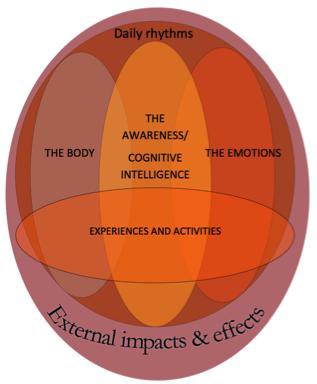
Bodily, cognitive and emotional experiences and activities support the child’s learning (see Figure 1). According to David Elliott (1995), in The Praxial Approach of Music Education, the triangle of these three elements are naturally provided, offering experiences, and thus benefitting development and learning. Musical creativity awakens emotions, it is formed through and with the support of the body, and also cognitively processed and understood.
As described by Odent (2008) in Marjanen (2009), the first experiences that can be comprehended as musical experiences, are the sounds of the mothers’ body and heartbeat, the womb sounds, blood circulation sounds etc. during the prenatal phase. The tactile sense effects also for the sound experiences, through the body vibration, understanding the whole body as an ear, and when understanding the ear not only as a listening sense, but also as a vestibular, proprioception and tactile sense – touching and listening may be a part of a modal fetal experiences. (Marjanen, 2009). The abílity to “feel” sound can be discussed about. Glennie (2002), as described by Dillon (2006) talks about the metaphor of music as life, with a piece of music evoking real, fictional or abstract scene from almost any area of human experience or imagination, talking also about the literal correspondence between hearing a sound and feeling a vibration (Dillon, 2006). In traditional societies sound and music, including dance and song, are integral to many aspects of life and culture (Dillon, 2006).
Other theories on music, creativity and learning, to support this paper
“Music is one of the most immediate forms of creative engagement with place, and a form with which students readily engage. Connections are made between place, creativity and music” (Dillon, 2006). In the four Ps model of creativity, it is seen through Process, Product, Person, and Place, and in the four-C model of creativity, creativity is divided in the levels of Big C (creative genious), little-c (everyday creativity), mini-c (creativity that occurs in a learning process, and Pro-C (expert-level of creativity) (Kaufman & Beghetto, 2009). Blending is a case of combinational creativity, including moving across and between disciplines, making connections and then focusing the outcomes of the blend (Pereira & Cardoso, 2002). This, because of integration, provides a framework and tools for working with any combination of disciplines, such as on a theme “a sense of place” (Dillon, 2006). The “sense of place” refers also to the concept of “narrative space” (Ropo, 2014), which can be found growing together with the learner as a consequence of the learning processes experienced, and affected through music education or sound education – music can be understood as an affective form of art combining vocal or instrumental sounds to produce beauty of form, harmony and expression of emotion, and sound as the clinical sensations caused by vibrations of air or other media (Dillon, 2006), and a form of communication, thus approaching education through music. Music, constructed of musical elements as sounds, may lead the child securely into postnatal life, like in the story that started this paper.
According to Perlovsky (2009/2010), on the basis of human vocal communication, emotionally filled vocal melodies have gradually evolved into consonant combinations of sounds. Through evolution our musical ability has shaped to create and perceive sound as something that is principally important for touching the whole of our being. Music is a special genre of arts, directly affecting the emotions.
Musical harmonies are based on inborn mechanisms. It has been found out also, that 4-month-old babies like consonant sounds and dislike dissonances (Perlovsky, 2009/2010, 5-6), referring to music experienced as a mirror of atmosphere – or something in connection with experiences and taste, right from the very beginning.
Musical learning links with transversal integration processes; these are constructed both through internal individual processes and external social interaction, and are also due to the impact of musical sounds. Discipline-specific curricula still dominate in educational systems, especially at secondary and tertiary levels, but there is a long- standing (and growing, as a writer’s remark, respectively) interest in working across, between and beyond disciplines (inter-, multi- and transdisciplinary) (Dillon, 2006).
Music possesses the capacity to move people emotionally. The emotions in music should cause us to be moved by music, for us to learn – with the connection to imagination: People listen with their imagination, if they have one (Kypourgos, 2012). Piaget (1896-1980) talks about love as the engine of cognitive education, complementing the idea of the emotions carried and transmitted in the form of musical communication. As Marjanen (2009b) has presented, learning processes are affected by flow experiences (Csikszentmihalyi, 1990) and supported by deep learning processes (Damasio, 1994; Hannaford 1995/2004), and strengthened by experiences of love and emotions (Odent, 2008; connected to Brown, 2000). These musical-emotional-interactive and creative processes start chemically and bodily even at the foetal stage (Chamberlain, 1996; Thaler, 1994). Musical imagination and emotions can be compared to the imagination and emotional dimensions of children’s play (Kurkela, 1994). Musical imagination and emotions are also connected to holistic learning experiences created through the dimensions of emotional, bodily and cognitive experiences, which are then combined in the limbic system of the brain (Hannaford, 1995/2004).
Different languages maintain a balance between the emotional and the conceptual (Perlovsky, 2009/2010). The tracks of musical and linguistic experiences can be originated in exactly the same areas of the brain (Jentschke, 2012). Language-learning processes already exist during the prenatal phase (Teinonen & Huotilainen, 2012).
Chamberlain (1996) describes the foetal responses in bodily responses. Marjanen (2009a; 2009b) suggests later vocal communication to derive from prenatal, holistic, musical-linguistic and bodily responses. This may later lead to or support the gaining of “the pedagogy of connection” (Dillon, 2006), consisting of a framework and tools to conceptualize and facilitate integrative work: creativity, the environment and music. Already the first connections between the mother and the fetus/baby are already affected strongly through music (Marjanen 2009a).
The study method
A study can be formed out of literature or from an empery, observing the information as a clarification or a description. The performance of the study can be called a model, with the phenomena being understood as theory. Research data can be constructed out of various genres of knowledge, and as a combination of them. It is possible to transform or translate tacit knowledge into the language of the propositions and claims suggested by explicating tacit knowledge into forms of theory to improve it on the basis of validity, reliability and adaptability. Routio (2007) claims that the content of tacit knowledge may be challenging for a researcher, unless during investigation, he himself simultaneously represents the practical field of the study. The unconscious cognitive and bodily processes associated with it are not adequate without the information itself (Pöyhönen, 2011). A child’s awareness starts as experimental information, through the senses, learning to give meanings, being aware, through activity- and concept information (Räsänen, 1993). This understanding, which formed the basis of the study procedure presently observed, was supported by The Theory of Multiple Intelligences (Gardner 1993; 1999) and the present-day brain research (e.g. Huotilainen, 2011; Overy, 1998). Gary McPherson (2013) also describes the connections between musical ability, development and identity. Based on the understanding of music, the study was performed as a process designed to gain information musically supported through the triangulation method; it comprised of diverse ways of data collection through observation, music workshops, discussion workshops, working in children’s study groups and an e-questionnaire. Figure 2 presents a summary of the data collection process.
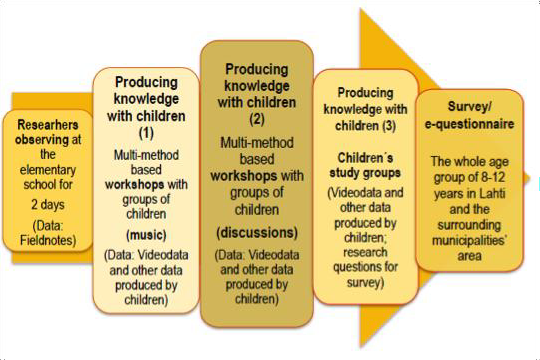
Important physical grounds for this investigation were to value and cherish the child’s ideas, to understand holistic interaction, which, as a part of the study, included mimicking, gestures and other activities. Open discussions took place on the basics of trust between the researcher and the participant.
The qualitative part of the study (observation, workshops) and the quantitative part (e-questionnaire) were viewed from approaches pertaining to the disciplines of philosophical sciences (music education), social sciences (social work), and educational sciences (teacher training, general education). Recognizing the phases of group dynamics and styles of interaction was found important for the study procedure (Nousiainen et al., 2007). Children from grades 2-6 (8-12 years) participated in the study workshops (n=81), also being involved in the e-questionnaire constructing process for the wider group of children to answer it (N=3731). Children’s discussions, shared experiences and expressions, rather than on some existing theories, were drawn on in to the questionnaire, which included some music and multimedia, as tools for communication and expression. The school organization collaborated with us to perform the study procedure with the children. The aim was set to reach the entire population of the area in question.
Problem Statement
In this paper, the problem statement is not purely to consider only the current study, but to bring it out to be discussed with in a wider framework. It is important to keep in mind, when developing the school curricula and the methods used, that the emphasis should not be put on the learning results but on the atmosphere surrounding the learning processes. Here, light is shed on learning in a way that comes natural to the child, and mirrored against the present study philosophy, ontology, epistemology, methodology and performance. With regards to teaching, the goals of music education, connected with the areas of holistic development (cognitive, socio-emotional, psychomotor and aesthetic) should be naturally combined (Marjanen, 2005; 2013). A positive atmosphere (including friendliness, elements of comfort imagination and creativity) that supports the idea of holistic development with positive experiences, will eventually strongly impact learning results and evoke the child’s motivation.
The results of the current study qualitative part are presented as a sum in Figure 3. Children explained to their positive well-being to include friendliness, imagination, creativity and the elements of comfort as the most important concepts, and described learning to happen all over within their living environments, not only at schools.
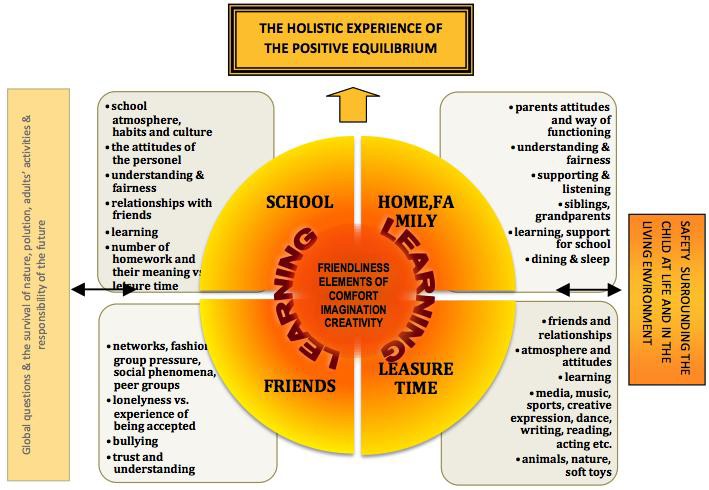
Research Questions
The Positive Equilibrium -study focused on the following:
The methodological aim: How to reach the conceptions of primary school children?
The content-based aim: What kind of things would children find as being important elements for the structures of their own positive wellbeing and equilibrium?
The methodological and content-based development and research aim: How would the survey developed from the qualitative data, serve and further develop the purpose of the study?
In this paper, it is asked on the basis of The Positive Equilibrium study:
What and how should we learn of the current study? Why to consider the information given by the children?
How and why is it important to consider the elements of creativity, imagination, friendliness and elements of comfort?
What might we learn about them when looking at e.g. The Pisa results or when creating new curricula?
Purpose of the study
The purpose of this paper was to discuss, in the light of The Positive Equilibrium of the Children –study, about the questions of music as a factor for creativity, to effect well-being and learning, as factors to possibly affect also the school success in the form of intrinsic motivation, maybe connected to later success in life, which leads us to the results of the Pisa studies, and to the ultimate goal of this paper to hear the children’s voices while developing the curricula, and while fostering our children.
Results
The actual study performance or results are not observed here as a whole. The intention is to affect the understanding the school organization and methodology as a part of the curricula. A child’s experience of positive wellbeing is greatly affected by the atmosphere surrounding him/her. This creates the basics for the equilibrium, which comprises of 1) feelings and experiences of trust, of being appreciated and valued; 2) Support of the home, parents, family and friends; 3) Relationships with friends; 4) Learning experiences; 5) The availability of elements of comfort; 6) An opportunity to gain the power of imagination and elements of creativity; and 7) The holistic, positive feeling of security experienced in the living environment, as presented in Fig. 3. When observing this information against the theories as presented in Chapter 2, the knowledge created would seem to be pointing out to the need of gripping on to the tools of music education more tightly than we generally do. The comprehension of music, as presented in Subchapter 2.2., from a wide perspective also supports anyone to be able to do it. The actual answers for the study questions were already given during the procedure of the present paper: a child can and should be musically supported.
Discussion
The quantitative data was supportive for the aims to interpret the present study results as a whole. For this paper’s purposes, however, the figure created from the qualitative data with regard to the results of the whole study was enough. The holistic understanding was constructed from the central features, as presented above, expressed by the children (Marjanen et al., 2012). The purpose of how and what the children told us may open our eyes and senses to review and understand the PISA results and our knowledge about the undeniable power of music, based on research, on human behavior, growth, development, abilities, understanding, atmosphere etc. Please see Figure 4.
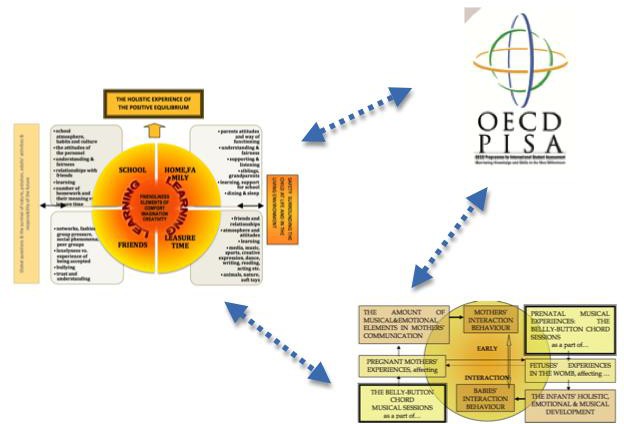
The meaning and the idea of music both individually and as a constructive element for our socio-cultural society, supports the claim to listen to the children’s message given in the study at our focus. In the PISA studies, the approach was constructed out of the traditional adult-based understanding on children’s learning processes, especially emphasizing the learning results. The theories and results presented in this paper mean mutual discussion and understanding between the learner and the teacher. Learning in, through, about, and with music, supports us in this, as both music and learning are based on interaction and would not exist without it.
Some new windows were opened due to the use of music as a tool for research. The researchers confronted many unexpected episodes, sometimes needing the ability to tolerate moments of chaos during the study processes (see Figure 2). As a reward of bearing these, rich, valuable, new, fresh information was gained.
Ethical issues were considered important during the actual study process, which was based on the agreements of both the children, their parents and teachers (agreements, information given, issues of freedom, e.g. making choices in present situations at school, and confidentiality). The close child/researcher relationship revealed and produced intertwined, repeated knowledge, sensitive issues, a testing of confidentiality and “gift-like-knowledge”.
Sufficient room for learning, coupled with the courage to trust the child’s abilities, motivation and understanding and a willingness to support and guide him are important. Through music we are able to construct close relationships, trust and creative interaction with the abilities to express and listen, and to use our imagination. From the results of the PISA studies in Finland, pupils’ attitudes, motivation and experiences of the school community were not very positive. It was also found out, that the Pisa scores are decreasing in Finland. This must be responded to.
An emphasis was placed on the right to play, to experience the arts, imagination and culture in the ‘Declaration of Children’s Rights’. Our present study strongly supports us in keeping these principles in mind. With this continuous rivalry we will always meet only dead ends. No understanding of continuous, sustainable grounds for development and learning can be found through the present policies for school education, teacher training and the all-around support for children as our antecedents and leaders of the next decades and generations. It should be our first priority to ground the child’s growth for the best possible understanding of human laws and the way we humans are constructed. The traces of learning results remain as images on the surface, with a better success if the learning processes are understood as more important than the immediate results: something important may turn out even with a very long delay. So let us provide and prepare sufficient room for learning, coupled with the courage to trust the child’s abilities, motivation and understanding and a willingness to support and guide him when needed. Following the tracks of transversal learning, starting with musical creativity, may carry us forward to a better understanding.
“To have a good life, it is important to have people around who gives support in moments of difficulties; kind, understanding parents who respect the choices you make during your life. A home and warmth, everything you need at home with someone to love you. As no one can go on alone, I think you will need a good partner to share your life. I may sound like someone’s mother but it is the truth and you just cannot change it. An adult’s life is not just a time for having fun, but no need to worry about this now as you still have many years before you grow up.
Remember, if you feel insecure you have to think why, because it is important. Choices made can always be changed. Life is waiting for you!!!” (Girl number 996, 853272, 6 th grade).
Acknowledgements
I express my sincere gratitude to the whole research team and to the University of Helsinki and TEKES for the funding of this research and for giving me the opportunity to be a part of this interesting investigation. Thank you for the interesting discussions and the positive learning atmosphere mutually created.
The author(s) declare that there is no conflict of interest.
References
Bronfenbrenner, U. (1979). The ecology of human development: experiments by nature and design. Cambridge, Mass.: Harvard U.P.
Brown, S. (2000). The “Musilanguage” model of music. In N. L. Wallin, B. Merker, & S. Brown (Eds.) The origins of music (pp. 271-300). London: The MIT Press.
Chamberlain, D. B. (1996). Babies are conscious. Originally an online publication in Jane English, Cesarean Voices, www.eheart.com/cesarean/babies.html
Csikszentmihalyi, M. (1990). Flow. The psychology of optimal experience. New York, NY: Harper & Grow.
Damasio, A. (2001). Descartesin virhe. Emootio, järki ja ihmisen aivot [The error of Descartes. Emotion, common sense and the human brain]. Helsinki: Terra Cognita.
Dillon, P. (2006). Creativity, integrativism and pedagogy of connection. International Journal of Thinking Skills and Creativity, 1, 69–83.
Elliott, D. J. (1995). Music matters: a new philosophy of music education. New York, NY: Oxford University press.
Hannaford, C. (2004). Viisaat liikkeet – aivojumpalla apua oppimiseen [Wise movements – brain gym as a support for learning]. Helsinki: Kehitysvammaliitto.
Jentschke, S. (2012). Music, language and the brain. A presentation in the European Music Portfolio Dissemination Conference, Stuttgart, Germany, 17th September, 2012.
Huotilainen, M. (2011). Greetings from brain research – music education is important for brain development. Proceedings of the 5th Conference of the European Network of Music Educators and Researchers of Young Children. Helsinki. Finland.
Kaufman, J. C., & Beghetto, R. A. (2009). Beyond big and little: The Four C Model of Creativity. Review of General Psychology, 13, 1-12.
Kurkela, K. (1994). Mielen maisemat ja musiikki. Musiikin esittäminen ja luovan asenteen psykodymnamiikka [2. Korjattu painos]. EST- julkaisusarja n:o 1. Esittävä säveltaide – tutkimuksia ja muita julkaisuja. Helsinki: Hakapaino Oy.
Kypourgos, N. (2012). Music and songs for children: stereotypes and paradoxes. Proceedings for the International Society for Music Education (ISME), Thessaloniki, Greece 2012. A Keynote Paper presented on July 16, 2012.
Marjanen, K., & Poikolainen, J. (2012). Lasten Ikihyvä – hyvinvoiva lapsi kuntapalveluissa. [The positive equilibrium of children – a wellbeing child within the communal services]. Lahti: University of Helsinki. Retrieved on December 20, 2012, from http://www.lastenikihyva.fi
Marjanen, K. (2009a). The Belly-Button Chord. Connections of Pre- and Postnatal Music Education with Early Mother-Child Interaction. University of Jyväskylä. Jyväskylä Studies in Humanities 130. A music education dissertation. Retrieved from https://jyx.jyu.fi/dspace/bitstream/handle/123456789/22602/9789513937690.pdf
Marjanen, K. (2009b). Musiikkitoiminnan suunnittelu varhaisiän musiikkitoiminnan näkökulmasta [Planning of musical activities from the viewpoint of early childhood music education]. In J. Louhivuori, P. Paananen, & L. Väkevä (Eds), Johdatus musiikkikasvatukseen [An introduction to music education]. Suomen musiikkikasvatusseura (Finnish Society for Music Education – FiSME.
Marjanen, K. (2005). Musiikkileikkikoulunopettaja, varhaismusiikkikasvatuksen ekspertti. Työelämä haasteena koulutukselle. Esimerkkitapauksena Jyväskylän ammattikorkeakoulu [Music playschool teacher, the expert in early childhood music education. Working life as a challenge to education. Jyväskylä University of Applied Sciences as an exemple]. Music education licentiate thesis. University of Jyväskylä. Retrieved from https://jyx.jyu.fi/dspace/bitstream/handle/123456789/22602/9789513937690.pdf
McPherson, G. (2013). Updating and refining conceptions of musical ability development and identity. Keynote, The 8th International Conference for Research in Music Educatio (RIME), 9-13th April, 2013, Exeter, Great Britain.
Nousiainen, L., & Piekkari, U. (2007). Osallistuva oppilas – yhteisöllinen koulu. Koulun kehittämisen kansio [A Participating pupil – a communcal school. A folder to develop the school.]. Helsinki: Opetusministerö.
Odent, M. (2008). Birth and Breastfeeding. Rediscovering the needs of women during pregnancy and childbirth. Clairview Books.
Peirson, L. J., Boydell, K. M., Ferguson, H. B., & Ferris, L. E. (2011). An ecological process model of systems change. American Journal of Community Psychology, 47, 307-321.
Overy, K. (1998). Can music really improve the mind? Psychology of music, 26(1), 97-99.
Perlovsky, L. I. (2009/2010). Musical emotions: Functions, origins, evolution. Physics of life reviews 7, 2-27.
Pöyhönen, M. (2011). Muusikon tietämisen tavat: moniälykkyys, hiljainen tieto ja musiikin esittämisen taito korkeakoulun instrumenttituntien näkökulmasta [The ways of knowing of a musician: Multiple intelligences, tacit knowledge and the art of performing manifested through the instrumental lessons of bachelor and post-graduate level students]. Doctoral Dissertation. Jyväskylä Studies in Humanities 164. University of Jyväskylä.
Ropo, E. (2014). Teachers and Teacher Education for the Finnish School. A Keynote Speech, Symposium for Creative Education. Chiplun, India.
Routio, P. (2007). Ammattien tiede. Tuotteiden ja palvelujen tutkimus ja kehittäminen [The science of professions. Investigating and developing products and services]. Retrieved from http://www2.uiah.fi/projects/metodi/kirja.doc.
Räsänen, M. (1993). Kuvasta kokemukseksi: kokemuksellinen oppiminen taidekuvan tarkastelussa [From an image to an experience: experimental learning in artistic images]. A Licentiate Thesis. Helsinki: TaiK.
Sulkunen, S., Välijärvi, J., Arffman, I., Harju-Luukkainen, H., Kupari, P., Nissinen, K., Puhakka, E., & Reinikainen, P. (2010). PISA09. Ensituloksia (PISA09. The first results) Opetus-ja kulttuuriministeriön julkaisuja, 21.
Teinonen, T., & Huotilainen, M. (2012). Implicit segmentation of stream of syllables based on transitional probabilities: a MEG study. In Journal of Psycholinguistic Research, 41(1), 71-82.
Thaler, D. S. (1994). The evolution of genetic intelligence. Science, 273, 1334-1336.
Tokie, N., Russell-Bowie, D., & Marjanen, K. (2013). The effectiveness of integrating music and other subjects on student’s development: the music education situation in Australia and Finland and its implications for Japan. Bulletin of Joetsu University of Education, 32.
Välijärvi, J. (2012). Suomalainen koulu oppimisen mahdollistajana ja kannustajana (Finnish school as a possibility and support for learning). In S. Sulkunen, & J. Välijärvi (Eds.), PISA09. Kestääkö oppimisen pohja? (PISA09. Will the ground for learning stand?)
Välijärvi, J. Kupari, P., Linnakylä, P., Reinikainen, P., Sulkunen, S., Törnroos. J., & Arffman, I. (2003). The Finnish success in PISA – and some reasons behind it 2. Jyväskylä: Institute for Educational Research, University of Jyväskylä.
Copyright information

This work is licensed under a Creative Commons Attribution-NonCommercial-NoDerivatives 4.0 International License.


